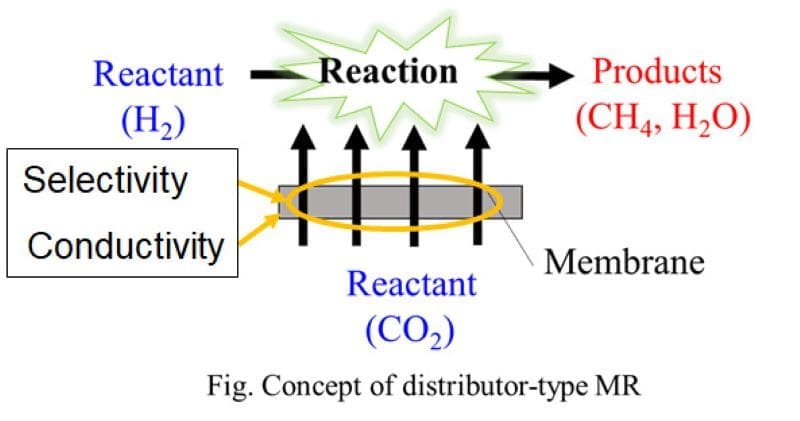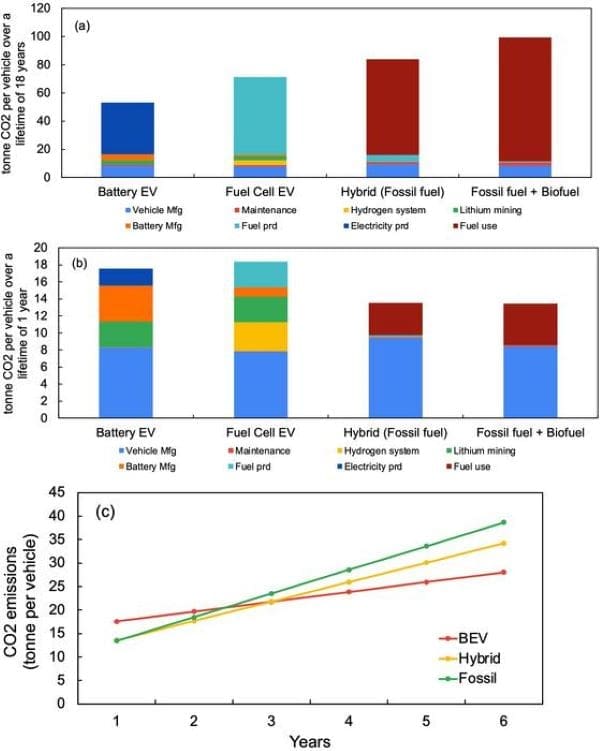Explore the latest insights from top science journals in the Muser Press daily roundup (October 30, 2025), featuring impactful research on climate change challenges.
In brief:
Distributor-type membrane reactor for carbon dioxide methanation
Climate change, expedited by anthropogenic activities, has become a major environmental concern in this century. Governments and organizations worldwide are gradually making substantial efforts to mitigate this challenge. A concrete step in this direction is to develop novel technologies that capture and convert low-concentration carbon dioxide into useful products.
Recently, scientists have proposed carbon dioxide methanation in a membrane reactor as a promising approach. Specifically, distribution-type membrane reactors are appealing owing to high catalyst activity through hotspot formation mitigation.
Although the effectiveness of membrane reactors has been confirmed, the efficiency of membrane properties and heat transfer characteristics of membrane materials remain unclear.
In a new study, a team of researchers led by Professor Mikihiro Nomura from Shibaura Institute of Technology, Japan, and including Yuka Shimizu from the same institute and Marcin Moździerz, Grzegorz Brus, and Elzbieta Fornalik-Wajs from AGH University of Krakow, Poland, has demonstrated the novelty of distribution-type membrane reactor for carbon dioxide utilization. Their findings were made available online on 17 September 2025 and have been published in Volume 462 of the journal Catalysis Today.

“Through a double degree program between Shibaura Institute of Technology and AGH University of Krakow, we evaluated heat transfer in membrane components, which enabled us to demonstrate the specific advantages of the membrane reactors addressed in our research,” explains Prof. Nomura.
Following this, the team controlled the reaction rate inside the reactor by distributed reactant feeding through the membrane. They subsequently conducted accurate thermal conductivity evaluation of the porous alumina (Al2O3) membrane with minute physical and chemical structural features via laser flash analysis measurements. The thermal conductivity in the solid part of this sample was measured to be 36.4% lower than that of non-porous alumina.
The researchers then utilized a catalytic membrane with a silica separation layer – with a hydrogen gas permeance of 1.4 × 10⁻⁶ mol m⁻² s⁻² Pa⁻¹ and a hydrogen-to-carbon dioxide selectivity of 35.9 – in the distributor-type membrane reactor test. They obtained a high carbon dioxide conversion of 92.3% at 350 °C.
Built on these results, the team carried out Ansys Fluent software-based simulations to examine the impact of membrane thermal conductivity and permselectivity. The team set carbon dioxide permeance of the membrane to 3.91 × 10⁻⁸ mol m⁻² s⁻² Pa⁻¹ for all situations, finding that the carbon dioxide permselective membrane with a high selectivity of 35.9 produces about 1.4 times more methane than the hydrogen permselective membrane with a low selectivity of 0.10. Furthermore, higher thermal conductivity of the membrane suppresses the temperature rise in the reactor.
“Membrane reactors enable spatially distributed reactant feeding within the reactor, providing enhanced control over reaction rates and temperature profiles in both the axial (flow) and the radial (membrane surface) directions. This unique capability and membrane shape make them well-suited for application in small-scale facilities. Therefore, applying membrane reactors to small-scale carbon dioxide emission sources – which are commonly owned by many small- and medium-sized enterprises with limited funding – will accelerate the realization of a carbon-neutral society. In particular, we anticipate their use in small combustion devices such as boilers, an area that has received little attention in efforts to combat global warming,” concludes Prof. Nomura.
These results can also guide other exothermic processes such as hydrocarbon partial oxidation in membrane reactor systems, boosting sustainable technologies.
Journal Reference:
Yuka Shimizu, Hiroto Tsuyuki, Marcin Moździerz, Grzegorz Brus, Shinichi Ookawara, Keita Yabe, Aleksandra Roszko, Elzbieta Fornalik-Wajs, Mikihiro Nomura, ‘Effect of membrane properties on CO₂ methanation reaction by using distributor type membrane reactor’, Catalysis Today 462, 115569 (2026). DOI: 10.1016/j.cattod.2025.115569
Article Source:
Press Release/Material by Shibaura Institute of Technology (SIT)
Drones reveal unexpectedly high emissions from wastewater treatment plants
“We show that certain greenhouse gas emissions from wastewater treatment plants have been unknown. Now that we know more about these emissions, we also know more about how they can be reduced,” says Magnus Gålfalk, docent at Tema M – Environmental Change at Linköping University, who led the study published in the journal Environmental Science & Technology.

Wastewater treatment plants receiving sewage from households and industries account for approximately 5 per cent of human-induced methane and nitrous oxide emissions, according to the UN Intergovernmental Panel on Climate Change, IPCC.
To calculate this, the IPCC uses so-called emission factors that are linked to how many households are connected to the treatment plant. The calculation model then yields a number for the emissions from each wastewater treatment plant. This number is an estimate and not the result of actual measurements, which has turned out to be problematic.
According to the researchers, wastewater treatment plants continuously work to reduce the emissions. But with the current reporting system, the emissions remain on the same level, according to the IPCC model, regardless of whether actual emissions are decreasing or not.
“It would be better if the emissions reported were based on actual measurements. This would make it easier for municipalities to show the benefits of investments to mitigate the emissions,” says Magnus Gålfalk.
Together with Professor David Bastviken at LiU, he has used a specially built drone that measured emissions of the greenhouse gases methane (CH₄) and nitrous oxide (N₂O) at twelve Swedish treatment plants that use anaerobic digestion as a sludge treatment. The measurements showed that methane and nitrous oxide emissions are significantly higher – about 2.5 times – than the IPCC calculation models show.
The emissions occurred mainly after digestion when the sludge is stored to reduce the amount of potentially harmful micro-organisms before being used as, for example, fertilizer. The current study shows that the amount of methane released in storage has been underestimated. And the researchers discovered something else – the measurements also showed that large amounts of nitrous oxide were emitted.
Nitrous oxide is a very powerful but fairly unknown greenhouse gas – it has a climate impact almost 300 times higher than carbon dioxide per kilogram.
“We show that the climate impact from nitrous oxide emissions from sludge storage is as great as that from methane, and this wasn’t known before. So it’s a major extra source to keep an eye on,” says Gålfalk.
Journal Reference:
Magnus Gålfalk and David Bastviken, ‘In Situ Observations Reveal Underestimated Greenhouse Gas Emissions from Wastewater Treatment with Anaerobic Digestion – Sludge Was a Major Source for Both CH₄ and N₂O’, Environmental Science & Technology 59, 34, pp. 18146-18155 (2025). DOI: 10.1021/acs.est.5c04780
Article Source:
Press Release/Material by Linköping University (LiU)
World’s leading medical journal details the climate emergency
New global findings in the 2025 Lancet Countdown on Health and Climate Change reveal that the continued overreliance on fossil fuels and failure to adapt to climate change continues to be paid in people’s lives, health, and livelihoods, with 13 of 20 indictors tracking health threats now reaching unprecedented levels.
The University of Sydney’s Heat and Health Research Centre contributed to the global report of the Countdown, which is published annually by The Lancet, the world’s leading medical research journal and is regularly among its most highly cited articles.
The annual indicator report, now in its ninth year, informs government policy globally with respect to climate change. It covers 50+ indicators tracking the impacts of, and efforts to adapt to, the ongoing health effects of climate change globally across five working groups, representing the work of 128 leading experts from 71 academic institutions and UN agencies globally.

Findings of 2025 report
This year’s report indicates:
- 2.5 million deaths every year being attributable to the air pollution that comes from continued burning of fossil fuels.
- Heat-related mortality per 100,000 increased by 23 percent since the 1990s, with total heat-related deaths reaching an average of 546,000 annually between 2012 and 2021
- The year 2024 was the hottest on record. Worldwide, the average person was exposed to a record extra 16 health-threatening hot days owing directly to climate change, with the most vulnerable (those aged under 1 year and over 65 years) experiencing, on average, an all-time high of 20 heatwave days – a 389 percent and 304 percent increase, respectively, from the 1986–2005 yearly average.
- Hotter and dryer conditions have fuelled conditions for wildfires, with fine particle pollution (PM₂·₅) from wildfire smoke resulting in a record 154,000 deaths in 2024 (up 36 percent from the 2003–2012 yearly average).
- Heat exposure resulted in a record 639 billion potential hours of lost labour productivity in 2024, with income losses equivalent to US$1.09 trillion (almost 1 percent of global GDP). At the same time, the costs of heat-related deaths in those over age 65 reached an all-time high of US$261 billion.
- Droughts and heatwaves increased the number of people experiencing moderate or severe food insecurity by 123 million in 2023, compared to the annual average between 1981 and 2010.
- Across 65 countries with low access to clean energy, air pollution from the household use of dirty fuels resulted in 2.3 million avoidable deaths in 2022; including some of the 2.52 million deaths still attributable to ambient air pollution from the burning of fossil fuels globally.
- High-carbon, unhealthy diets contributed to 11.8 million diet-related deaths in 2022, which could largely be avoided by transitioning to healthier, climate-friendly food systems.
- Over 128 million hectares of forest were destroyed in 2023 (up 24 percent since 2022), diminishing the world’s natural capacity to mitigate climate change.
- 15 out of 87 countries responsible for 93 percent of global CO₂ emissions spent more on net fossil fuel subsidies than their national health budgets in 2023.
- Governments collectively spent $US956 billion on net fossil fuel subsidies in 2023. Meanwhile oil and gas giants keep expanding their production plans – to a scale three times greater, on projected production, by 2040 than a liveable planet can support.
- Private banks are supporting fossil fuel expansion, with the top 40 lenders to the fossil fuel sector collectively investing a five-year high of $US611 billion in 2024 (up 29 percent from 2023). This exceeded their green sector lending by 15 percent.
Positive action
The report also details actions local governments, individuals, civil society, and the health sector are undertaking to shape a healthier future including:
- A growing number of cities (834 of 858 reporting in 2024) have completed or intend to complete climate change risk assessments.
- The health sector itself has shown climate leadership, with health-related greenhouse gas emissions falling 16 percent globally between 2021 and 2022.
- Almost two-thirds of medical students around the world received climate and health education in 2024, building capacity for further progress.
- An increased shift away from coal, particularly in wealthy countries, prevented an estimated 160,000 premature deaths yearly between 2010 and 2022, due to fine particulate air pollution from burning fossil fuels.
- The share of electricity generated by modern renewables reached a record-high 12 percent in 2022, with the clean energy transition generating healthier, more sustainable jobs.
Professor Anthony Costello, Co-Chair of the Lancet Countdown warned: “As a rising number of world leaders threaten to reverse the little progress to date, urgent efforts are needed at every level and in every sector to both deliver and demand accelerated action that will yield immediate health benefits. As some governments uphold an unsustainable, unhealthy and ultimately unliveable status quo, people around the world are paying the ultimate price. We have to build on the momentum we have seen from local action: Delivering health-protective, equitable, and just transition requires all hands on deck.”
Journal Reference:
Romanello, Marina et al., ‘The 2025 report of the Lancet Countdown on health and climate change’, The Lancet (2025). DOI: 10.1016/S0140-6736(25)01919-1. Also available on ScienceDirect.
Article Source:
Press Release/Material by University of Sydney
Electric vehicles outperform gasoline cars in lifetime environmental impact
After two years of use, lithium-ion battery electric vehicles (BEVs) result in a reduction in cumulative carbon dioxide (CO₂) emissions compared to fossil-based internal combustion engine (ICE) vehicles, according to a new study published this week in the open-access journal PLOS Climate by Pankaj Sadavarte of Duke University, US, and colleagues.
The transportation sector accounts for 28% of US greenhouse gas emissions in the US and growing consensus supports electric vehicle adoption to address climate and air quality challenges. However, ongoing debate surrounds whether lithium-ion batteries are truly cleaner when considering their complete manufacturing and operational lifecycle.

In the new study, researchers used the Global Change Analysis Model (GCAM) integrated assessment model to evaluate CO₂ and air pollutant emissions across four scenarios of increasing electric vehicle adoption in the United States through 2050. The analysis included emissions from fuel production, battery manufacturing, vehicle assembly, and operation for both electric and gasoline vehicles.
The study concluded that during the first two years of operation, electric vehicles produce 30% higher CO₂ emissions than gasoline vehicles when all lifecycle factors are considered. The higher initial emissions stem from energy-intensive lithium mining and battery manufacturing processes. However, after the second year of on-road use, electric vehicles begin reducing cumulative emissions compared to gasoline alternatives. Moreover, as battery output increases over time, each additional kWh of lithium-ion battery output leads to an average reduction of 220 kg of CO₂ in 2030 and 127 kg of CO₂ in 2050.
Accounting for both air pollution and climate change impacts, the economic value of environmental damage from ICE vehicles over their lifetime currently ranges from 2 to 3.5 times that of BEVs.
Co-author Dr. Drew Shindell summarizes: “Internal combustion vehicles lead to about 2-3 times more damage than EVs when considering both climate and air quality.”
The authors point out that several assumptions were made regarding the mileage of the passenger car, life of a vehicle, and average battery size of the passenger car in the US. Moreover, the study did not consider the associated emissions due to infrastructure required to meet the increasing demand for electric charging. However, they conclude that relative benefits of BEVs are expected to increase over coming decades as electricity generation becomes cleaner through reduced fossil fuel use.
Lead author Dr. Pankaj Sadavarte adds: “Our research shows that transitioning from fossil fuel vehicles to battery electric vehicles (BEVs) can significantly improve climate and air quality over time. While BEVs initially have higher lifecycle emissions due to extraction and battery production, our analysis using the Global Change Analysis Model demonstrates that they quickly outperform internal combustion vehicles – cutting carbon dioxide emissions and reducing harmful air pollutants. As the U.S. electricity grid becomes cleaner, the economic and environmental advantages of BEVs will only grow stronger.”
Journal Reference:
Sadavarte P, Shindell D, Loughlin D, ‘Comparing the climate and air pollution footprints of Lithium-ion BEVs and ICEs in the US incorporating systemic energy system responses’, PLOS Climate 4 (10): e0000714 (2025). DOI: 10.1371/journal.pclm.0000714
Article Source:
Press Release/Material by PLOS
Featured image credit: Gerd Altmann | Pixabay




